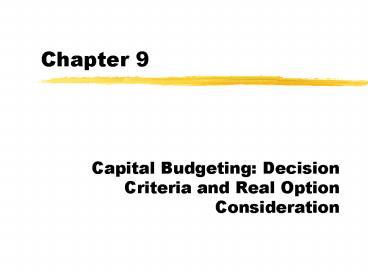Capital Budgeting: Decision Criteria and Real Option Consideration - PowerPoint PPT Presentation
1 / 12
Title:
Capital Budgeting: Decision Criteria and Real Option Consideration
Description:
If A, B, and C mutually exclusive, choose A (use NPV) when there is no capital ... May have contradictory decisions for mutually exclusive projects. ... – PowerPoint PPT presentation
Number of Views:231
Avg rating:3.0/5.0
Title: Capital Budgeting: Decision Criteria and Real Option Consideration
1
Chapter 9
- Capital Budgeting Decision Criteria and Real
Option Consideration
2
Evaluation Models
- Net present value (NPV)
- Profitability Index (PI)
- Internal rate of return (IRR)
- Payback (PB) period
3
NPV
- NPV PVNCF - NINV
- where
- For independent projects, all projects with NPV ?
0 is acceptable. For mutually exclusive
projects, choose the one with the highest NPV. - Advantage consistent with SWM
- Disadvantage absolute value, not relative
4
NPV -- example
- Example 1 from Chapter 8.
- NINV 62K
- NCF15 14.4, 19.5, 27.55, 22.54, 34.46 K
- Cost of capital 8
CF0 - 62, CF114.4, CF219.5, CF327.55,
CF422.54, CF534.46, I/YR8 gt NPV
29.94 CF0 0, CF114.4, CF219.5, CF327.55,
CF422.54, CF534.46, I/YR8 gt PVNCF 91.94
gtNPV91.94-6229.94
5
Profitability Index
- PI PVNCF / NINV
- For independent projects, all projects with PI ?
1 is acceptable. Should yield identical
decisions as NPV method. - For mutually exclusive projects, decision may be
different from NPV method. Should consider other
factors.
6
PI NPV -- example
- Project A
- PVNCF 92K
- NINV 62K
- NPV92-6230
- PI92/621.48
- Project C
- PVNCF 20K
- NINV 10K
- NPV20-1010
- PI20/102
- Project B
- PVNCF 27K
- NINV 30K
- NPV27-30-3
- PI27/300.9
- If A, B, and C independent, choose both A and
C - If A, B, and C mutually exclusive, choose A
(use NPV) when there is no capital rationing,
choose C (use PI) when facing capital rationing.
7
Internal rate of return (1)
NPV PVNCF - NINV, where
IRR the rate of return that will make the
project break even (have a NPV0)
- Example 1 from Chapter 8.
- NINV 62K
- NCF15 14.4, 19.5, 27.55, 22.54, 34.46 K
CF0 - 62, CF114.4, CF219.5, CF327.55,
CF422.54, CF534.46, gt IRR 22.66
8
IRR (2)
- Decision rules
- Independent projects all projects with
r ? cost of capital - Mutually exclusive projects project with the
highest r (r ? cost of capital) - Advantage takes account both the magnitude and
the timing of cash flows - Disadvantage possible existence of multiple
internal rate of returns
9
IRR NPV (1)
- Identical decisions for independent projects
- May have contradictory decisions for mutually
exclusive projects. - NPV assumes cash flows are reinvested
(compounded) at the firms cost of capital --
more realistic - IRR assumes cash flows are reinvested
(compounded) at IRR
10
IRR NPV (2)
- Cost of capital 8
- Project X
- NINV 62K
- NCF15 14.4, 19.5, 27.55, 22.54, 34.46
- Project Y
- NINV 62K
- NCF15 0, 0, 10, 20, 120
- Project X
- NPVx29.25
- IRRx22.66
- Project Y
- NPVy42.31
- CF05 -62, 0, 0, 10, 20, 120
- I/YR 8
- IRRy 20.68
- CF05 -62, 0, 0, 10, 20, 120
- If X and Y independent, choose both X and Y
- If X and Y mutually exclusive, choose X (use
NPV)
11
Payback (PB) period
- Undiscounted PB period
- Discounted PB period
- Special case undiscounted PB period of equal
annual net cash flows - Example project X and Y
12
Homework
- page 365-366, question 2, 3, 4, 5
- page 367-371, problem 4, 9, 16, 18































